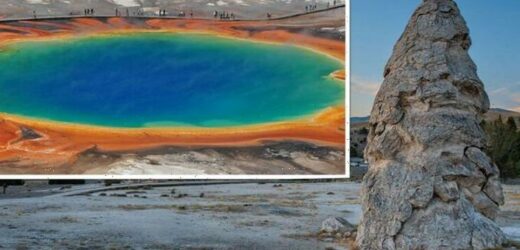Yellowstone volcano: 'Super-eruption' predicted by expert
We use your sign-up to provide content in ways you’ve consented to and to improve our understanding of you. This may include adverts from us and 3rd parties based on our understanding. You can unsubscribe at any time. More info
The Yellowstone National Park is perhaps one of North America’s most famous wilderness areas. It features in the new Netflix series, Our Great National Parks, narrated by former President Barack Obama. The five-parter sees him visit various national parks in the US while narrating over their histories and environments, exploring the flora and fauna that call the areas home.
While Yellowstone is famous for its outstanding natural beauty, what has really attracted millions of visitors and scientists to it is its supervolcano status.
It has experienced just three eruptions in the last three million years, the last coming 630,000 years ago, which was 1,000 times bigger than the Mount St Helens eruption in 1980 — an event that caused more than $1billion (£741million) in damage.
During the last eruption, the sheer volume of material caused the ground to collapse, creating a depression now known as the caldera, which is 55 kilometres by 80 kilometres wide.
The next eruption is expected to have catastrophic effects worldwide, and was explored during What If’s short documentary, ‘What If the Yellowstone Volcano Erupted Tomorrow?’


Here, a simulation of a Yellowstone eruption and its subsequent effects were played out.
The narrator noted: “Right now, in the US, one of the world’s largest volcanoes is gearing up to explode.
“If Yellowstone decided to erupt, the results would be devastating.
“It has erupted three times in the past three million years which has led some people to wonder whether we should be worried about another eruption in the near future.
JUST IN: Yellowstone scan exposes huge underground ‘plumbing’

“But if the eruption took place tomorrow and you lived in North America, there would be virtually nothing you could do to prepare.”
It is worth noting that in geological and volcanic terms, “near future” can mean hundreds of thousands of years away.
The documentary looked at the potential lava output, noting that Yellowstone would produce little in the way of lava flows.
Before lava becomes lava, it is something known as magma.
But much of Yellowstone’s magma would not turn into lava because the intensity of its eruption would force most of it to shoot into the sky.
So, rather than becoming magma, it would transform into airborne ash particles, small, scorching pieces of jagged rocks, in and of themselves potentially lethal.
DON’T MISS
Yellowstone warning sign should trigger ‘mother of all evacuations’ [REPORT]
Supervolcano: Experts warned new threat ‘rising up’ beneath US [INSIGHT]
Yellowstone volcano warning: ‘Huge rocks’ could ‘crush’ public [ANALYSIS]


This ash would soon blanket the region and the surrounding region, and would eventually cover more or less the entire US and Canada.
Tens of millions of people living within a 1,000 kilometre (621-mile) radius would die from the ash alone.
Once breathed in, it would form a cement-like mixture in the lungs, causing gradual suffocation.
Infrastructure would also be destroyed by the ash: just 30 centimetres (12 inches) of it is enough to cave-in roofs.
And, experts suggest that even those outside the 1,000 kilometres range would still be in trouble.

The east coast of the US would see around a centimetre of ash fall on its shores, an amount still dangerous to human lungs.
Some of this ash would also travel to Europe, and the rest of the world would experience some extreme weather changes.
The global temperature, it has been estimated, would drop by around 10°C and could last as long as a decade.
Crops would also be affected, as well as water supplies and general agricultural produce.
NASA has spent years looking at the potential outcomes of a Yellowstone eruption, in the process attempting to devise strategies that would curb the fallout.

The agency has even suggested ways to prevent an eruption in the first place.
One scenario would see an increase in the amount of water within the Yellowstone caldera to extract its heat day-by-day in order to reduce the risk of an eruption.
Practically speaking, however, this would cost millions, leaving politicians unlikely to sign up and hand over the cash.
But another plan that may give governments more of an incentive to join sees a hole drilled 10 kilometres into Yellowstone and water pumped into it at a high pressure.
This would circulate the water and return it at an estimated temperature of 350C (662F), and slowly day by day extracting heat from the volcano.
Estimates suggest such a project would come at a cost of around $3.46billion (£2.69billion), but would generate electric power at competitive prices, and so comes with an enticing catch which could convince politicians to make the investment.
Source: Read Full Article


